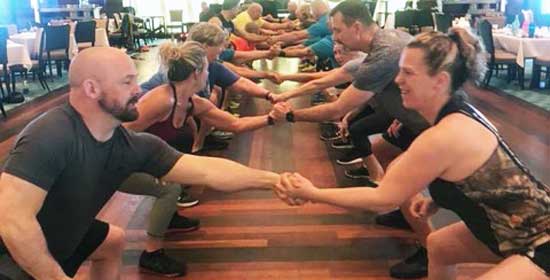
When you first became a health and exercise professional, you probably imagined yourself teaching fitness or training clients at a gym or studio in the town or city where you live. But have you considered occasionally taking your talents on the road with services that pair working out with vacationing?
Fitness-related getaways can increase income, build and strengthen community among your client/members, and freshen up a fitness routine with something new and exciting. Here, three fitness pros share how they’ve leveraged their teaching skills to offer clients active vacations at desirable destinations.
Why Fitness Getaways Are Appealing
You don’t have to try very hard to entice people into taking a vacation—but are they as willing to work out while away? Many clients would say yes! In fact, not only are they willing, they prefer it. That’s a huge opportunity for health and exercise pros looking to expand their services.
“Many people have made fitness a daily habit and they don’t want to stop while on vacation,” says Tom Holland, M.S., exercise physiologist, Chief Fitness Advisor at Nautilus, Inc., and CEO /founder of Team Holland LLC, a fitness consulting company based in Darien, Conn. “Add in a spectacular outdoor location to exercise and you really have a unique offering.”
Client/Member Retention
Fitness vacations are a good way for you and participants to meet and connect with new people from around the country or world. Or—as Travis Barnes of Horseheads, N.Y., has done—you might frame it as a chance to build community among local gym members. Barnes is the founder of FITBIZ Mastery and CEO of Journey 333, a franchise gym. “In a sense, we are like extended family to our members, so they really enjoy the thought of connecting more outside the gym to deepen those relationships,” he says. Not surprisingly, bonding during fitness getaways can amplify customer loyalty later on. “A greater connection with your members equals greater retention,” says Barnes.
Being Present
There’s also the transformative benefit of travel. Picture the average class or training session when you aren’t away. People arrive in various moods, including stressed about work, troubled about an issue at home, or frazzled from traffic or tardiness. Vacations temporarily strip away most of those upsets, allowing clients to enjoy heightened well-being and balance. “The demeanor of the people on vacation is vastly different,” says Holland. “They are relaxed and ready for you to give them a great experience.”
“It’s so different to get away,” says Alberta-based Ami McMullen, an international fitness presenter, TRX master trainer and owner of FitGetaway.com. “When I ran my first small event, I had some local people join and they were rushing off right after classes to get back home to deal with work and family. I wished, for their sake, that they could have had more time to chill out.” This is one reason why McMullen chose an international location for the next fitness vacation she’s hosting (see sidebar for more details). “I want people to really relax and be there for themselves and nobody else,” she says.
Before You Start Marketing Your Fitness Getaway
If hosting a fitness getaway sounds like a viable opportunity for you, you’ll want to unpack a few details before officially announcing your plans. “Start planning early—like a year before your event,” says McMullen. “Lots of places are booked up in advance, and lots of hotels/services in island locations are truly on ‘island time.’” Reserve plenty of time for correspondence with host sites.
Depending on the venue, you might need a permit to run classes, trainings or boot camps. Similar to managing bylaws back home, you can’t just show up on a public beach and get going. “You need to get permission to hold your camp, often from the town in which it will be held,” says Holland. “They will often require a fee, proof of insurance, waivers and even appearing at a town meeting in person.” For two decades, Holland has been successfully teaching annual on-the-beach fitness camps for Nantucket summer vacationers, building up a following that includes people who plan their vacation around his class schedule. (See sidebar for details.)
“The top few things I take into consideration when planning my event are the exact things I take into consideration when planning my own vacation,” says McMullen, a seasoned traveler.
Cost and duration are obvious variables. The fee must be reasonable for participants but still profitable for the trainer. “Get an idea of what your main population normally spends on a vacation,” advises Barnes. “Look for all hidden costs before promoting the event. These might include resort fees, taxes, gratuities, port charges (for a cruise), permits, etc. As for duration, a few days, up to a week, seems about right.
Of course, don't forget the workouts. Their caliber must be worth the travel and precious vacation time, which means you’ll want to offer an elevated experience. Determine what equipment, if any, you need to pack if there won’t be anything available at the destination; pre-plan where everyone will work out.
To that end, location is one of the most important elements. “It has to be somewhere that people are dying to go to so they will spend the time and money, but not so far away that it’s exhausting to get there and back,” says McMullen. International travel is an option as long as it’s not too cumbersome.
Finally, there’s timing to consider, which can affect everything from unfavorable weather to overbooked accommodations. Also, don’t lose sight of what’s happening close to home during your proposed travel dates. If you plan to recruit folks from a specific area or gym, timing could make or break registrations. For example, look at local community events and school calendars. “You will exclude school faculty and their kids from being able to go if you don’t consider the school calendar,” says Barnes.
Pack Your Bags!
Once you’ve hosted your first fitness getaway, you’ll have a better idea of what works and what you can improve for next time. To streamline your efforts and build on profitability, it helps to venture forward with a long-range vision. “Start your camp with the intention of doing it for many years to come,” says Holland.
Finally, strategize how this journey will benefit you and the participants. For example, Barnes suggests evolving the experience into a high-level, VIP coaching program back at home. “Members who choose to go on trips like this are looking to connect more with you,” he says. “Thinking of this in advance allows you to sell the program on the trip.”
Whether the fitness vacation you host ends when the vacation ends or morphs into a new, back-in-town adventure, your role in inspiring people to go farther with their fitness journeys brings many financial and emotional rewards.

Where: Nantucket Island
When: Classes are held for 10 days in the first two weeks of August, Monday through Friday. These morning classes last one hour and cost $40 per person, per day.
Who it's for: These classes are for people already on Nantucket for a vacation, and all ages and fitness levels are welcome.
Itinerary: “My beach fitness camp takes place every weekday morning on Jetties Beach, one of the most picturesque settings imaginable,” says Holland. There is no equipment needed other than a few cones and flags to mark the beach. Participants go through stations with body-weight exercises, core work, relay races and more.
“I started the classes to make money while on vacation as well as to make money in the summer, a time when income takes a huge hit for many personal trainers,” says Holland. Back then, he couldn’t afford to place an ad, and only a handful of people showed up. “Twenty years later, the classes generate thousands of dollars per hour, have been featured in the media and have numerous sponsors,” he says.
How many people are needed to run the program? How many before it’s sold out? Holland has had 80+ people in a class, which he found to be too big. Now he tries to limit class attendance to 50 people per day

Where: Tulum, Mexico
When: February 7-11, 2019
Who it's for: This getaway is geared to women, but men are welcome as well.
Itinerary: “The program is about resetting for the sake of sleep and stress relief and getting healthy meals and movement each day,” says McMullen.
Staying at an eco resort and spa, participants gather for a late-morning TRX workout followed by brunch. The itinerary includes free time for beach/sleep/exploration. In the afternoons, participants attend workshops about balanced living, followed by dinner and drinks, socializing or sleep. The event includes hotel shuttle transportation, five days, four nights beachfront accommodation, all meals, a one-hour massage and a guided group hike. Cost: $1,995 USD (paid upfront or in installments).
How many people are needed to run the program? How many before it’s sold out?
A minimum of five people is needed to break even, and the getaway is sold out at approximately 16 people.

Where: Punta Cana, Dominican Republic. Previously, Barnes hosted a cruise to the Bahamas.
When: Seven days during winter
Who it’s for: This vacation is offered to members of Barnes’ gym plus their families and friends. “We open this up to nonmembers because this is a great opportunity to show them why they’d want to be part of our community,” says Barnes.
Itinerary: Barnes and his team provide three workout days and three retreat days focused on personal development. “Beyond that,” says Barnes, “we let everyone know where we have chosen to have dinner and where we have chosen to go on excursions. We invite them to join us, but they also have the freedom to enjoy something different.” The cost depends on location and trip type (destination, cruise).
How many people are needed to run the program? How many before it’s sold out?
“Last year we had 53 people, and we are planning to double that number this year,” says Barnes. The number of guests depends on space availability for workouts and gatherings. “Investigate the space you will have, then set your participant limit,” says Barnes.





 by
by 





